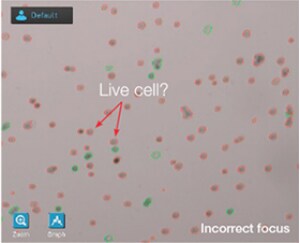Search Thermo Fisher Scientific
Cell Counting Information

Cell counting can be a critical step in any experiment that involves comparing different cell populations or responses. In this section you will find application notes, videos and technical guides to help you achieve more accurate cell counts and ultimately more accurate results.
Cell counting features
White paper

The four pillars of achieving accurate and precise cell counts
Regardless of the chosen cell counting method, achieving an accurate and precise count from repetitive counts of a single sample or across multiple samples is critical, yet sometimes challenging. Learn the four pillars of accurate and precise cell counting to help your lab minimize variability and maximize cell counting confidence.
Application note

Comparison of cell counting methods
The most common method for counting cells uses a microscope and hemocytometer. Advancements in imaging technology have enabled the automation of cell counting, providing improved accuracy and reliability, with much less time and effort. This application note compares these two methods.
Cell counting learning resources
No records were found matching your criteria
| Type | Title | Categories |
|---|---|---|
| Application note (2011) | Novel detection and direct cell counting of marine, photosynthetic picoplankton by flow cytometry | Attune/Attune NxT, cell counting, flow cytometer/flow cytometry, flow cytometry sample preparation |
| Application note (2015) | Fluorescent viability assays on the Countess II FL Automated Cell Counter | automated cell counter, cell counting, Countess, EVOS, fluorescent dyes, ReadyProbes, viability |
| Application note (2015) | Fluorescent protein reporter gene transduction efficiency measured with the Countess II FL Automated Cell Counter | automated cell counter, cell counting, Countess, EVOS, fluorescent dyes, genetic transduction |
| Application note (2015) | Fluorescent apoptosis evaluation on the Countess II FL Automated Cell Counter | apoptosis, automated cell counter, cell counting, Countess, EVOS, fluorescent dyes, viability |
| Application note (2015) | Comparison of cell counting using Countess II Automated Cell Counters vs. hemocytometers | automated cell counter, cell counting, Countess, hemocytometer |
| Application note (2016) | Blood cell counting using the Countess II FL Automated Cell Counter | automated cell counter, brightfield microscopy, cell counting, cell counting sample preparation, Countess, EVOS, fluorescent dyes, immunophenotyping, ReadyProbes |
| Application note (2017) | Simple and accurate monitoring of adipogenesis | adipocyte, adipogenesis, automated cell counter, cell differentiation, Countess, EVOS, fluorescence microscopy/fluorescence imaging, fluorescent dyes, live-cell imaging, onstage incubator, stem cell research |
| BioProbes article (2009) | Automated cell counting at your fingertips | automated cell counter, cell counting, Countess, fluorescent dyes, viability |
| BioProbes article (2010) | Easy and accurate counting of stem cells | automated cell counter, cell counting, Countess, stem cell research |
| BioProbes article (2014) | Obtain the highest-quality data your system can deliver—Fluorescent microspheres for calibrating microscopes and flow cytometers | calibration, cell counting, flow cytometer/flow cytometry, flow cytometer set up and calibration, fluorescence microscopy/fluorescence imaging, immunophenotyping, microscope calibration, particles |
| BioProbes article (2014) | Introducing a three-channel cell counter for your benchtop—The new and improved Countess II FL Automated Cell Counter | cell counting, automated cell counter, brightfield microscopy, Countess, EVOS fluorescence microscopy/fluorescence imaging |
| BioProbes article (2015) | Fluorescence-based viability assays for the Countess II FL Automated Cell Counter—Incorporate automation into your cell analysis workflows | automated cell counter, cell counting, Countess, EVOS, fluorescence microscopy/fluorescence imaging, viability |
| BioProbes article (2016) | High-Speed Cell Counting With the Attune NxT Flow Cytometer—Accurately measure cell concentrations by flow cytometry | Attune/Attune NxT, cell concentration, flow cytometer/flow cytometry, microbiology, viability |
| Molecular Probes Handbook | Assays for cell enumeration, cell proliferation and cell cycle—Section 15.4 | cell counting, cell cycle, cell proliferation |
| Scientific poster (2008) | Cell-based potassium ion channel screening with the FluxOR Assay | BacMam technology, cell counting, Countess, fluorescent dyes, high content analysis, ion flux/ion channels, microplate reader |
| Scientific poster (2008) | Improving downstream results with automated cell counting | automated cell counter, BacMam technology, cell counting, cell expansion, cell isolation, Countess, fluorescent dyes, hemocytometer, ion flux/ion channels, microplate reader |
| Scientific poster (2009) | Accuracy and precision comparison of the hemocytometer and automated cell counting methods | automated cell counter, cell counting, Countess, hemocytometer, particles, viability |
| Scientific poster (2012) | A novel no-wash, no-lyse method for residual leukocyte enumeration using acoustic focusing flow cytometry and a cell-membrane permeant DNA dye | Attune/Attune NxT, cell counting, flow cytometer/flow cytometry, flow cytometry sample preparation, fluorescent dyes, immunophenotyping, rare-event detection, violet laser-excited reagents |
| Scientific poster (2016) | No-lyse no-wash new strategy for CD34+ for absolute cell counting without beads | antibodies, Attune/Attune NxT, flow cytometer/flow cytometry, flow cytometry compensation, immunophenotyping, multicolor flow cytometry, particles |
| Webinar | DNA content cell cycle analysis using flow cytometry Find out how careful acquisition and methodical preparation contribute to accurate and consistent DNA analysis. In this webinar we'll discuss: An overview of the methods and materials for using flow cytometry to determine cell cycle by measuring DNA content Selection of DNA dyes for live cell and fixed cell analysis Tips and tricks for consistent results | cell counting, cell cycle, cell proliferation, flow cytometer/flow cytometry |
| White paper (2015) | Accuracy and precision with the Countess II FL Automated Cell Counter | automated cell counter, brightfield microscopy, cell counting, Countess |
For Research Use Only. Not for use in diagnostic procedures.